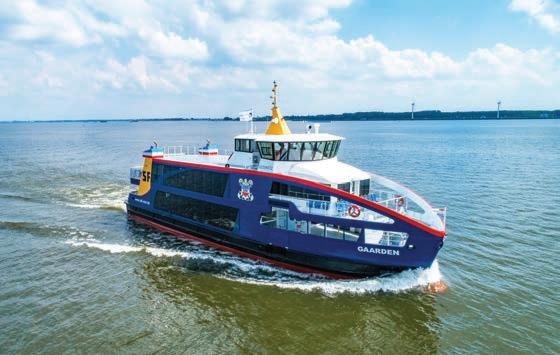
2 minute read
the salmon farming industry Three vessels for Schlepp- und Fährgesellschaf Kiel
AFTER DELIVERING HYBRID FERRY GAARDEN IN JULY 2020 AND THE FULLY ELECTRIC FERRY DÜSTERNBROOK THAT WILL BE ENTERING OPERATIONS SHORTLY, HOLLAND SHIPYARDS GROUP HAS SIGNED A CONTRACT TO BUILD THREE ADDITIONAL HYBRID VESSELS FOR SCHLEPP-UND FÄHRGESELLSCHAFT KIEL (SFK).
ALL PHOTOS COURTESY OF HOLLAND SHIPYARDS GROUP.
The design of the three additonal vessels is in line with the previously delivered vessel Gaarden. The ferries will measure 32.4m by 8.8m and will be provided with a hybrid drivetrain that can be powered by either generators or by means of a batery bank. The frst two ferries will be delivered in February and May 2022 and the last one in the beginning of 2026. Ansgar Stalder of Schlepp- und Fährgesellschaf Kiel states, “Holland Shipyards successfully prevailed in a European tender among twelve other shipyards. The contract included four ferries but was split into a prototype and an opton of three additonal vessels. The Gaarden has been in service for several months and has been fulflling her dutes, so Schlepp- und Fährgesellschaf Kiel are confdent to extend the contract as originally intended.”
Green mission
With the new vessels, SFK is renewing their current feet. The replacement of the feet is in line with the environmental goals set by SFK and the city of Kiel. The city of Kiel aims to be CO₂ neutral by 2050 and expects shipping to play a major part in this shif. Replacing the feet adds great value to this and Holland Shipyards Group is proud to contribute to this. With a role in building green vessels, Holland Shipyards Group is commited to work on a greener future for the maritme industry. The Holland Shipyards Group 2021’s orderbook contains about a dozen fully electric or hybrid ferries. “Propulsion systems are key in developing green vessels, therefore we are always investgatng sustainable propulsion methods”, Holland Shipyards Group states. “This year we will be taking a pioneering step by retroftng a vessel to run on hydrogen fuel cell propulsion. Our green mission is not only visible in the vessels we build, but in the producton process as well. Green vessels need to be built in a sustainable way. When it comes to materials selecton, we are making green choices, and our workshops, where we control air quality and emissions, have a green character as well. This year, a large number of solar panels will be installed on our workshops. Our aim is to generate as much energy as we use. Going green is not an opton, but a necessity to leave a habitable planet to the next generatons to come. We will contnue doing our part.”
i. hollandshipyardsgroup.com











